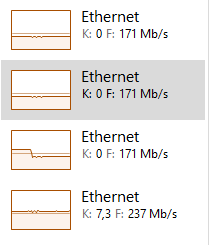5
0
We have a computer (running Windows 10) with five Ethernet ports (each 1 Gb), two of them are built-in, the other three are on two PCIe cards. Four of the Ethernet ports have in total six cameras plugged into them (with two switches, so no port handles more than two cameras at once). The system was originally designed to run distributed over several computers because the cameras send uncompressed images, so there is a service running (originally on each computer) that grabs the frames and hands them over to a recording/display program (now in a compressed format).
When the system is running, the four Ethernet ports are way below their theoretical limit:

On the other hand, when looking at the service handling the incoming traffic, I see 99% usage (it was 100% but I set all cards to gigabit full duplex, then it dropped to 99%) while the actual usage is pretty much the sum of the four incoming traffics (headers in order: CPU, memory, network, disk, GPU):
As you can see, memory and CPU usage is very low, and the 800 Mb/s speed should be WAY below the capacity of the network, yet it shows 100% and the capturing program functions as if it were having serious bandwidth issues. Downscaling to four cameras (and around 600 Mb/s total) restores behaviour.
The strangest thing of all, is that for a few trials the six cameras in total were working perfectly, so my feeling is that Windows 10 is somehow thinking we only have 1000 Mb/s bandwidth and is trying to limit usage which somehow kicked in later.
What am I missing?
Hardware (edit)
Motherboard: GA-X99-Designare EX
Devices listed in device manager:
- Intel Ethernet Connection (2) I218-V
- Intel I211 Gigabit Network Connection
- Intel PRO/1000 PT Dual Port Server Adapter
- Intel PRO/1000 PT Dual Port Server Adapter #2
- Realtek PCIe GBE Family Controller
Two PCIe NICs:
- TP LINK TG-3468
- GigE Card PCIe Intel PRO/1000 PT Dual Port Server Adapter
The interface statuses:
Name InterfaceDescription ifIndex Status MacAddress LinkSpeed
---- -------------------- ------- ------ ---------- ---------
Ethernet Intel(R) I211 Gigabit Network Connec... 12 Up 1C-1B-0D-6C-A0-27 1 Gbps
Ethernet 2 Intel(R) Ethernet Connection (2) I218-V 15 Up 1C-1B-0D-6C-A0-29 1 Gbps
Slot04 x16 Realtek PCIe GBE Family Controller 14 Up 18-D6-C7-01-C9-F6 100 Mbps
Ethernet 4 Intel(R) PRO/1000 PT Dual Port Ser...#2 9 Up 68-05-CA-3F-CB-32 1 Gbps
Ethernet 3 Intel(R) PRO/1000 PT Dual Port Serve... 20 Up 68-05-CA-3F-CB-33 1 Gbps
It seems that the Realtek GBE (which should be the TP LINK TG-3468, which says it can do 1 Gbps) is on 100 Mbps. It's connected with a Cat5e cable to a gigabit switch. I'm not sure this is relevant, but also seems strange.

So, there's no actual problem except that Windows may have a incorrect metric measuring Network usage? – music2myear – 2018-03-28T17:20:08.470
@music2myear No, unfortunately, after a brief period of working fine, the capture system is acting like it is not having enough bandwidth. This is why I have the feeling Windows might think we don't have enough and is trying to artifically limit usage by one program. – fbence – 2018-03-28T17:24:22.837
I'm not aware of any built-in throttling behavior in Windows. – music2myear – 2018-03-28T17:47:51.747
How are the devices connected (ie IP addresses of cameras and ports)? What type of NICs are you using? – davidgo – 2018-03-28T19:04:53.853
The adapters all have localaddresses 192.168.X.1 where X is 0 to 3, the cameras all have 192.168.X.Y where X is the respective adapter they're plugged into and Y is 2 or 3. The one used for internet (the fifth) is has a static non-local IP. The single port NIC is a TP LINK TG-3468, there are two on the motherboard (GA-X99-Designare EX is the board: Dual Intel® GbE LAN with cFosSpeed Internet Accelerator Software), for the third one I'd have to check. I think the cameras use port 80, and the service and recorder uses some random ports at the high end. – fbence – 2018-03-28T19:25:26.873
What's the motherboard model this is running on? – Tim_Stewart – 2018-03-29T05:10:48.880
@Tim_Stewart: GA-X99-Designare EX – fbence – 2018-03-29T05:16:19.017
the name of the capture service software might be useful. – Yorik – 2018-04-11T16:03:40.787
It's the Etoservice.exe in the picture, unfortunately, it was costume made. The creator says there should not be any limits due to the software, but I'm trying to lay my hands on the code. – fbence – 2018-04-11T16:19:46.843
Should use "adapters" instead of "ports". – harrymc – 2018-04-11T17:10:13.900